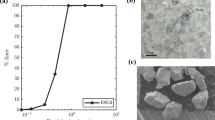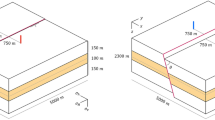Abstract
The generation, accumulation, and release of corrosion gases is an important issue in the assessment of long-term repository performance. For repository concepts in clay-rich rock formations such as the Opalinus Clay of Northern Switzerland the transport path through the Excavation Damage Zone (EDZ) around the emplacement tunnels is of particular interest because the gas transport capacity of the host rock is limited and therefore a significant fraction of the produced gas could be released along the EDZ. This article describes the development of a structured approach to abstract complex geoscientific models of two-phase flow through the EDZ to simplified models suitable for use within a Probabilistic Safety Assessment (PSA). The approach utilizes three different models: a discrete fracture network (DFN) model of the EDZ, an equivalent heterogeneous continuum porous medium (CPM) model and a simplified CPM model suitable for use within PSA. Equivalent properties of the elements of the heterogeneous CPM models are upscaled from DFN realizations. Results from gas injection simulations with the heterogeneous CPM models are then used to derive appropriate parameters for the simplified CPM model. The modeling presented in this article represents the first step in the development of a structured methodology for treatment of gas, solute, and water flow through the EDZ. The emphasis is on methodology development, and both input data and structural models used in this study are of a generic nature and would have to be adapted to the actual conditions at a real repository site.
Similar content being viewed by others
Abbreviations
- α :
-
van Genuchten capillary strength (= 1/P 0) (Pa−1)
- \({\varphi}\) :
-
Porosity (–)
- k :
-
Permeability (m2)
- k 0 :
-
Reference permeability (m2)
- k h :
-
Horizontal permeability (m2)
- k r :
-
Radial permeability (m2)
- k r,l :
-
Relative permeability to liquid
- k r,g :
-
Radial permeability to gas
- K :
-
Hydraulic conductivity (m/s)
- m :
-
van Genuchten shape factor (m = 1 − 1/n)(–)
- n :
-
van Genuchten shape factor (–)
- P 0 :
-
Reference capillary strength pressure (Pa)
- S s :
-
Specific storage (–)
- S l :
-
Liquid saturation
- S ec :
-
Effective saturation (–)
- S gr :
-
Residual gas saturation (–)
- S lr :
-
Residual water saturation (–)
References
Armand, G., Doe, T., Piédevache, M., Chavane, G.: Permeability measurements in the excavation damaged zone in the Opalinus Clay at Mont Terri Rock Laboratory, Switzerland. In: Proceeding of 57th Canadian Geotechnique Conference, Paper G15-453 (2004)
Bossart P., Meier P.M., Moeri A., Trick T., Mayor J.C.: Structural and hydrogeological characterisation of the excavation-disturbed zone in the Opalinus Clay. Appl. Clay Sci. 26(1–4), 429–448 (2004)
Finsterle S.: Multiphase inverse modeling: review and iTOUGH2 applications. Vadose Zone J. 3, 747–762 (2004)
Grant, M.A.: Permeability Reduction Factors at Wairakei, paper 77-HT-52, presented at AICHE-ASME Heat Transfer Conference, Salt Lake City, Utah (1977)
Hartley, L.J., Holton, D.: CONNECTFLOW (Release 8.0) Technical Summary Document, Serco Assurance Report (2004)
Jackson C.P., Hoch A.R., Todman S.: Self-consistency of a heterogeneous continuum porous medium representation of a fractured medium. Water Resour. Res. 36(1), 189 (2000)
Leverett M.C.: Capillary behavior in porous solids. Trans. Soc. Pet. Eng. AIME 142, 152–169 (1941)
Marschall P., Horseman S., Gimmi T.: Characterisation of gas transport properties of the Opalinus Clay, a potential host rock formation for radioactive waste disposal. Oil Gas Sci. Technol. 60(1), 121–139 (2005)
Martin, C.D., Lanyon, G.W.: EDZ in Clay Shale: Mont Terri, Mont Terri Technical Report. 2001-01 (2003)
McNeish. J.: Total System Performance Assessment-License Application/Methods and Approach. DOE, DOC.20031215.0001 (2003)
NAGRA, Project Opalinus Clay: safety report. Demonstration of disposal feasibility for spent fuel, vitrified high-level waste and long-lived intermediate-level waste (Entsorgungsnachweis). NAGRA Technical Report NTB 02-05. Nagra, Wettingen, Switzerland (2002a)
NAGRA, Projekt Opalinuston—Synthese der geowissenschaftlichen Untersuchungsergebnisse. Entsorgungsnachweis für abgebrannte Brennelemente, verglaste hochaktive sowie langlebige mittelaktive Abfälle. NAGRA Technical Report NTB 02-03. NAGRA, Wettingen, Switzerland (2002b)
Pruess K., Tsang Y.: On two-phase relative permeability and capillary pressure of rough-walled rock fractures. Water Resour. Res. 26(9), 1915–1926 (1990)
Pruess, K., Oldenburg, C., Moridis, G.: TOUGH2 User’s Guide, Version 2.0, Lawrence Berkeley National Laboratory, LBNL-43134 (1999)
Pruess K., Faybishenko B., Bodvarsson G.S.: Alternative concepts and approaches for modeling flow and transport in thick unsaturated zones of fractured rocks. J. Contam. Hydrol. 38(1–3), 281 (1999)
Senger, R.K., Marschall, P., Lavanchy, J.-M.: In: Ian, G., McKinley, Charles McCombie (eds.) Gas threshold pressure tests in deep boreholes for determining two-phase flow properties of the host rock at the proposed L/ILW repository, Switzerland. Scientific Basis for Nuclear Waste Management XXI, Davos (1998)
Sevougian, S.D., Jain, V., Luik, A.V.: The integration and abstraction of EBS models in Yucca Mountain Performance Assessment. SAND2006-0172P (2006)
Snow D.T.: Anisotropic permeability of fractured media. Water Resour. Res. 5(6), 1273–1289 (1969)
Author information
Authors and Affiliations
Corresponding author
Rights and permissions
About this article
Cite this article
Lanyon, G.W., Senger, R. A Structured Approach to the Derivation of Effective Properties for Combined Water and Gas Flow in the EDZ. Transp Porous Med 90, 95–112 (2011). https://doi.org/10.1007/s11242-011-9716-y
Received:
Accepted:
Published:
Issue Date:
DOI: https://doi.org/10.1007/s11242-011-9716-y




